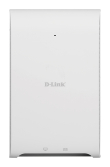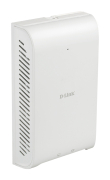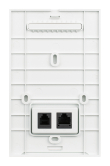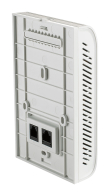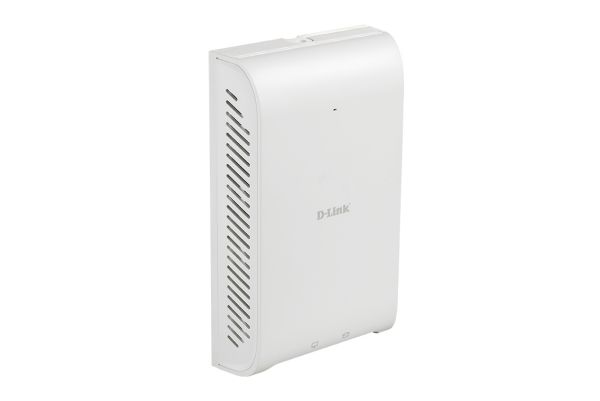
DAP-2620
Description
The DAP-2620 Wireless AC1200 Wave 2 Dual-Band PoE Access Point is designed for small to medium businesses or enterprises, providing unparalleled bandwidth and flexibility for administrators looking to deploy a medium to large scale Wi-Fi network. This AP has manageable dual-band wireless LAN options and utilizes the cutting-edge speed of Wireless AC.
DAP-2620 can be managed by Nuclias Connect Controller. The Nuclias Connect solution provides for easier administration of wireless networks, including continuous monitoring of network activities, equipment configuration automation, performance parameters and network security control etc.
Blazing Wireless Wave 2 AC Performance
The DAP-2620 delivers reliable, high-speed wireless performance using the latest 802.11aс1 standards with maximum wireless signal rates of up to 300 Mbps over the 2.4 GHz band, and 867 Mbps over the 5 GHz band. This, coupled with support for the Wi-Fi Multimedia™ (WMM) Quality of Service (QoS) feature, makes it an ideal access point for audio, video, and voice applications. When enabled, QoS allows the DAP-2620 to automatically prioritize network traffic according to the level of interactive streaming, such as HD movies or VoIP.
Versatile Access Point Functionality
The DAP-2620 allows network administrators to deploy a highly manageable and extremely robust simultaneous dual-band wireless network. The DAP-2620 can provide optimal wireless coverage over either the 2.4 GHz (802.11b, 802.11g, and 802.11n) or the 5 GHz (802.11a, 802.11n and 802.11ac) bands. For advanced installations, the DAP-2620 has integrated 802.3af Power over Ethernet (PoE) support, allowing the device to be installed in areas where power outlets are not readily available.
Security
To help maintain a secure wireless network, the DAP-2620 supports both Personal and Enterprise versions of WPA and WPA2 (802.11i), with support for RADIUS server backend and a built-in internal RADIUS server allowing users to create their accounts within the device itself. This access point also includes MAC address filtering, wireless LAN segmentation, SSID broadcast disable, rogue AP detection, and wireless broadcast scheduling for further protection of your wireless network. The DAP-2620 includes support for up to eight VLANs per band, allowing multiple SSIDs to be implemented and further segment users on the network. It also includes a wireless client isolation mechanism, which limits direct client-to-client communication. Additionally, the DAP-2620 supports Network Access Protection (NAP), allowing network administrators to define multiple levels of network access based on individual client's needs.
Network Management
Network administrators have multiple options for managing the DAP-2620, including web (HTTP/HTTPS), Secure Shell (SSH, which provides for a secure channel between local and remote computers), and Telnet. In addition, the DAP-2620 has a wireless scheduler feature, which turns off wireless functionality when it isn't needed, saving power.
Multiple Operation Modes
DAP-2620 supports several operating modes: Access Point, Wireless Distribution System (WDS), WDS with AP, Wireless Client. As a standard wireless access point (AP) the DAP-2620 can connect to a wide range of devices that are 802.11n/g/b/ac compliant. In wireless distribution system (WDS) mode it can expand current wireless coverage without the need for a wired backbone link. As a wireless client it can connect to an existing AP and and provide access to the network for devices connected using an Ethernet cable. The DAP-2620 also features advanced features such as load balancing and redundancy, for fail-safe wireless connectivity.
MU-MIMO Technology
The DAP-2620 supports MU-MIMO (Multi-User Multiple Input Multiple Output), which enables the device to simultaneously communicate with multiple clients using multiple antennas. This allows the access point to utilize the spectrum more efficiently and significantly increase the network capacity.
General features
|
Hardware
|
|
|
RAM
|
• 128MB, DDR2
|
|
Flash
|
• 16MB, SPI
|
|
Interfaces
|
• 802.11a/b/g/n/ac Wave 2 wireless1
• 1x10/100/1000Base-T LAN 802.3af PoE port
• 1x10/100/1000Base-T LAN port
• 2 RJ11 ports
|
|
LEDs
|
• Power/Status
- Solid green - Device operational
- Flashind red - Device booting up/Device malfunctioned
- Solid red - Device boot up has failed
|
|
Buttons
|
• Factory reset button
|
|
Antennas
|
• Two internal antennas with 2 dBi for 2.4 GHz
• Two internal antennas with 2 dBi for 5 GHz
|
|
Wireless Module Parameters
|
|
|
Standards
|
• IEEE 802.11a/b/g/n/ac1
|
|
Wireless Frequency Range
|
• 2.4 GHz: 2.4 GHz to 2.4835 GHz
• 5 GHz: 5.15 GHz to 5.825 GHz 2
|
|
Wireless Security
|
• WPA-Personal/Enterprise
• WPA2-Personal/Enterprise
• 64/128-bit WEP encryption
• AES and TKIP
• SSID broadcast disable
• MAC address access control
• Network Access Protection (NAP)
• Internal RADIUS server
• Captive Portal Authentication
|
|
Wireless speed
|
• 802.11a: 6, 9, 12, 18, 24, 36, 48 and 54 Mbit/s
• 802.11b: 1, 2, 5.5 and 11 Mbit/s
• 802.11g: 6, 9, 12, 18, 24, 36, 48 and 54 Mbit/s
• 802.11n: 6.5 ~ 300 Mbit/s
• 802.11ac: 6.5 ~ 867 Mbit/s
|
|
Transmitter Output Power*
* The maximum value of the transmitter output power depends upon the radio frequency regulations applied in your country.
|
• IEEE 802.11a:
20 dBm at 6 Mbit/s
20 dBm at 9 Mbit/s
20 dBm at 12 Mbit/s
20 dBm at 18 Mbit/s
20 dBm at 24 Mbit/s
20 dBm at 36 Mbit/s
18 dBm at 48 Mbit/s
18 dBm at 54 Mbit/s
• IEEE 802.11b:
20 dBm at 1, 2, 5.5, 11 Mbit/s
• IEEE 802.11g:
20 dBm at 6 Mbit/s
20 dBm at 9 Mbit/s
20 dBm at 12 Mbit/s
20 dBm at 18 Mbit/s
18 dBm at 24 Mbit/s
18 dBm at 36 Mbit/s
16 dBm at 48 Mbit/s
16 dBm at 54 Mbit/s
• IEEE 802.11n:
2.4 GHz/HT-20:
20 dBm at MCS0
20 dBm at MCS1
20 dBm at MCS2
20 dBm at MCS3
18 dBm at MCS4
18 dBm at MCS5
16 dBm at MCS6
15 dBm at MCS7
2.4 GHz/HT-40:
16 dBm at MCS0
16 dBm at MCS1
16 dBm at MCS2
16 dBm at MCS3
15 dBm at MCS4
15 dBm at MCS5
14 dBm at MCS6
14 dBm at MCS7
5 GHz/HT-20:
20 dBm at MCS0
20 dBm at MCS1
20 dBm at MCS2
20 dBm at MCS3
20 dBm at MCS4
18 dBm at MCS5
18 dBm at MCS6
17 dBm at MCS7
5 GHz/HT-40:
19 dBm at MCS0
19 dBm at MCS1
19 dBm at MCS2
19 dBm at MCS3
19 dBm at MCS4
18 dBm at MCS5
18 dBm at MCS6
17 dBm at MCS7
• IEEE 802.11ac:
VHT20:
20 dBm at MCS0
20 dBm at MCS1
20 dBm at MCS2
20 dBm at MCS3
20 dBm at MCS4
18 dBm at MCS5
18 dBm at MCS6
17 dBm at MCS7
16 dBm at MCS8
VHT40:
19 dBm at MCS0
19 dBm at MCS1
19 dBm at MCS2
19 dBm at MCS3
19 dBm at MCS4
18 dBm at MCS5
18 dBm at MCS6
17 dBm at MCS7
16 dBm at MCS8
14 dBm at MCS9
VHT80:
19 dBm at MCS0
19 dBm at MCS1
19 dBm at MCS2
19 dBm at MCS3
19 dBm at MCS4
18 dBm at MCS5
18 dBm at MCS6
17 dBm at MCS7
16 dBm at MCS8
14 dBm at MCS9
|
| Receiver Sensitivity |
• IEEE 802.11a:
-85 dBm at 6 Mbit/s
-82 dBm at 9 Mbit/s
-79 dBm at 12 Mbit/s
-77 dBm at 18 Mbit/s
-76 dBm at 24 Mbit/s
-75 dBm at 36 Mbit/s
-73 dBm at 48 Mbit/s
-72 dBm at 54 Mbit/s
• IEEE 802.11b:
-89 dBm at 2 Mbit/s
-84 dBm at 11 Mbit/s
• IEEE 802.11g:
-86 dBm at 6 Mbit/s
-83 dBm at 9 Mbit/s
-80 dBm at 12 Mbit/s
-78 dBm at 18 Mbit/s
-77 dBm at 24 Mbit/s
-76 dBm at 36 Mbit/s
-74 dBm at 48 Mbit/s
-73 dBm at 54 Mbit/s
• IEEE 802.11n:
2.4 GHz/HT-20:
-84 dBm at MCS0
-83 dBm at MCS1
-82 dBm at MCS2
-78 dBm at MCS3
-76 dBm at MCS4
-72 dBm at MCS5
-71 dBm at MCS6
-70 dBm at MCS7
2.4 GHz/HT-40:
-82 dBm at MCS0
-80 dBm at MCS1
-79 dBm at MCS2
-75 dBm at MCS3
-73 dBm at MCS4
-69 dBm at MCS5
-68 dBm at MCS6
-67 dBm at MCS7
5 GHz/HT-20:
-83 dBm at MCS0
-82 dBm at MCS1
-81 dBm at MCS2
-77 dBm at MCS3
-75 dBm at MCS4
-71 dBm at MCS5
-70 dBm at MCS6
-69 dBm at MCS7
5 GHz/HT-40:
-81 dBm at MCS0
-79 dBm at MCS1
-78 dBm at MCS2
-74 dBm at MCS3
-72 dBm at MCS4
-68 dBm at MCS5
-67 dBm at MCS6
-66 dBm at MCS7
• IEEE 802.11ac:
VHT20:
-83 dBm at MCS0
-82 dBm at MCS1
-81 dBm at MCS2
-77 dBm at MCS3
-75 dBm at MCS4
-71 dBm at MCS5
-70 dBm at MCS6
-69 dBm at MCS7
-64 dBm at MCS8
-62 dBm at MCS9
VHT40:
-81 dBm at MCS0
-79 dBm at MCS1
-78 dBm at MCS2
-74 dBm at MCS3
-72 dBm at MCS4
-68 dBm at MCS5
-67 dBm at MCS6
-66 dBm at MCS7
-61 dBm at MCS8
-59 dBm at MCS9
VHT80:
-79 dBm at MCS0
-76 dBm at MCS1
-75 dBm at MCS2
-71 dBm at MCS3
-69 dBm at MCS4
-65 dBm at MCS5
-64 dBm at MCS6
-63 dBm at MCS7
-58 dBm at MCS8
-56 dBm at MCS9
|
|
Functionality
|
|
|
Network Management
|
• Web interface (HTTP/HTTPS)
• Secure Telnet (SSH)
• Telnet
• Traffic control
• Nuclias Connect
|
|
Operating Modes
|
• Access Point
• WDS
• WDS with AP
• Wireless Client
|
|
Supported Features
|
• Quality of Service (QoS)
• Multi-SSID
• VLAN
• Wireless intrusion
• Internal RADIUS server
• Band Steering
• ARP Spoofing Prevention
• Bandwidth Optimization
• DHCP Server
• MAC address access control
|
|
Standards
|
• IEEE 802.3u
• IEEE 802.3ab
• IEEE 802.3az Energy-Efficient Ethernet (EEE)
• IEEE 802.3af Power over Ethernet
|
|
Physical Parameters
|
|
|
Weight
|
• 212 g (without mounting base)
|
|
Dimensions (L x W x H)
|
• 153.5 x 94.65 x 35.8 mm
|
|
Operation Conditions
|
|
|
Power Supply
|
• IEEE 802.3af PoE
|
|
Max Power Consumption
|
• 8 W
|
|
Temperature
|
• Operating: 0° to 40°C
• Storage: -20° to 65°C
|
|
Humidity
|
• Operating: 10% to 90% (Non-condensing)
• Storage: 5% to 95% (Non-condensing)
|
|
Package Contents
|
|
|
• DAP-2620 Access Point
• Wall mounting bracket
• Quick Installation Guide
|
|
|
Other
|
|
|
Certifications
|
• FCC
• CE
|
Certificates
Order info
| DAP-2620 |
Wireless AC1200 Wave 2 Dual-Band PoE Access Point
|
